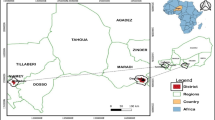Abstract
Tree damage, gauged by the amount of defoliation, is one of the basic criteria used to determine treatments for protected and economic forests. Monitoring should include an assessment of the degree of tree damage in different spatial scales. Therefore, in addition to the commonly applied large-area methods, small-area methods should be used. The aim of the paper is to present the results of the accuracy assessment of a small-area method, proposed by Podlaski (2005) [Podlaski, R. (2005). Inventory of the degree of tree defoliation in small areas. Forest Ecology and Management, 215, 361–377], for monitoring the degree of tree damage. The degree of tree damage was shown in sub-blocks P3 of the system of information on natural environment (SINUS). To estimate the spatial distribution of the degree of tree defoliation, survey sampling, based on simple random sampling with replacement (SRSWR), was used. The degree of damage to fir (Abies alba Mill.) and beech (Fagus sylvatica L.) was analysed in the Święty Krzyż forest section in the Świętokrzyski National Park. The maximum total estimation errors for the proportion of trees with a degree zero of damage, and with second and third degrees of damage together (for α = 0.05) were at most 30.8% for fir and 24.3% for beech trees. For standard, small-area evaluations, these are satisfactory values. In the Święty Krzyż forest section, the number of P3 sub-blocks with 0.00–5.00% of undamaged trees and with 80.01–100.00% of moderately- or severely-damaged trees was significantly greater for fir than for beech. These results indicate that the fir population was unhealthier than the beech group in the study area. P3 sub-blocks of the SINUS system, in which the proportion of the healthiest trees was highest, were situated at the forest margin, bordering on meadows and arable fields (in the case of fir) and forming dense patches consisting of several sub-blocks, or occurring singly in the whole study area (in the case of beech). The results show the significant differentiation of forest tree health in small areas.
Similar content being viewed by others
References
Borecki, T., & Keczyński, A. (1992). Atlas ubytku aparatu asymilacyjnego drzew leśnych. Warszawa: Agencja ATUT.
Ciołkosz, A. (1991) SINUS – system informacji o środowisku przyrodniczym. In S. Mazur (Ed.), Ekologiczne Podstawy Gospodarowania Środowiskiem Przyrodniczym. Wizje – problemy – trudności (pp. 317–328). Warszawa: Wyd. SGGW-AR.
Cochran, W. G. (1977). Sampling techniques. New York: Wiley.
Conover, W. J. (1980). Practical nonparametric statistics. New York: Wiley.
FAO ISRIC ISSS (1998). World reference base for soil resources, 84 World Soil Resources Reports. Rome: FAO.
Ghosh, S., Innes, J. L., & Hoffmann, C. (1995). Observer variation as a source of error in assessments of crown condition through time. Forest Science, 41, 235–254.
Goreaud, F., & Pélissier, R. (1999). On explicit formulas of edge effect correction for Ripley’s K-function. Journal of Vegetation Science, 10, 433–438.
Jaszczak, R. (1999). Historia monitoringu kondycji lasów w Polsce. Sylwan, 143(2), 5–25.
Jaworski, A. (1982). Fir regression in Polish mountain areas. European Journal of Forest Pathology, 12, 143–149.
Jaworski, A., Karczmarski, J., Pach, M., Skrzyszewski, J., & Szar, J. (1995). Ocena żywotności drzewostanów jodłowych w oparciu o cechy biomorfologiczne koron i przyrost promienia pierśnicy. Acta Agraria et Silvestria, Series silvestris, 33, 115–131.
Koronacki, J., & Mielniczuk, J. (2001). Statystyka. Warszawa: Wydawnictwa Naukowo-Techniczne.
Law, A. M., & Kelton, W. D. (2000). Simulation modelling and analysis. New York: McGraw-Hill.
Lorenz, M., Mues, V., Becher, G., Seidling, W., Fischer, R., Langouche, D., et al. (2002). Forest condition in Europe. Results of the 2001 large-scale survey. Geneva, Brussels: United Nations Economic Commission for Europe, European Commission.
Matuszkiewicz, J. M. (2002). Zespoły leśne Polski. Warszawa: PWN.
Palenka, J., Konôpka, B., & Bucha, T. (1996). Poškodenie lesov v oblasti Spiša. Zvolen: LVÚ.
Penttinen, A. (2000). Small-area statistics in mapping of geo-referenced data. In The Yearbook of The Finnish Statistical Society 1999–2000 (pp. 39–48). Finnish Statistical Society.
Podlaski, R. (2004). Validation of a small-area method for estimating the spatial distribution of the degree of tree damage. European Journal of Forest Research, 123, 229–237.
Podlaski, R. (2005). Inventory of the degree of tree defoliation in small areas. Forest Ecology and Management, 215, 361–377.
Regulation (EC) no 2152/2003 of the European Parliament and of the Council of 17 November 2003 concerning monitoring of forests and environmental interactions in the Community (Forest Focus), Official Journal of the European Union, L324/1, 11.12.2003.
Ripley, B. D. (1981). Spatial statistics. New York: Wiley.
Roesch Jr., F. A. (1993). Adaptive cluster sampling for forest inventories. Forest Science, 39, 655–669.
Solberg, S., & Strand, L. (1999). Crown density assessments, control surveys and reproducibility. Environmental Monitoring and Assessment, 56, 75–86.
Spiecker, H., Mielikäinen, K., Köhl, M., & Skovsgaard, J. P. (1996a). Conclusions and summary. In H. Spiecker, K. Mielikäinen, M. Köhl, & J. P. Skovsgaard (Eds.), Growth trends in European forests (pp. 369–372). Berlin, Heidelberg, New York: Springer.
Spiecker, H., Mielikäinen, K., Köhl, M., & Skovsgaard, J. P. (1996b). Discussion. In H. Spiecker, K. Mielikäinen, M. Köhl, & J. P. Skovsgaard (Eds), Growth trends in European forests (pp. 355–367). Berlin, Heidelberg, New York: Springer.
Talvitie, M., Leino, O., & Holopainen, M. (2006). Inventory of sparse forest populations using adaptive cluster sampling. Silva Fennica, 40, 101–108.
Thompson, S. K. (1990). Adaptive cluster sampling. Journal of the American Statistical Association, 85, 1050–1059.
Thompson, S. K. (1991). Stratified adaptive cluster sampling. Biometrika, 78, 389–397.
Wawrzoniak, J., & Małachowska, J. (2004). Dynamika poziomu uszkodzeń drzewostanów w latach 1999–2003. In J. Wawrzoniak, & J. Małachowska (Eds.), Stan uszkodzenia lasów w Polsce w 2003 roku na podstawie badań monitoringowych (pp. 19–21). Warszawa: Biblioteka Monitoringu Środowiska, Inspekcja Ochrony Środowiska.
Zieliński, R. (1972). Tablice statystyczne. Warszawa: PWN.
Zieliński, R., & Zieliński, W. (1990). Tablice statystyczne. Warszawa: PWN.
Author information
Authors and Affiliations
Corresponding author
Rights and permissions
About this article
Cite this article
Podlaski, R. Accuracy assessment of a small-area method for estimating the spatial distribution of the degree of tree damage. Environ Monit Assess 135, 339–351 (2007). https://doi.org/10.1007/s10661-007-9654-x
Received:
Accepted:
Published:
Issue Date:
DOI: https://doi.org/10.1007/s10661-007-9654-x




